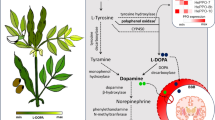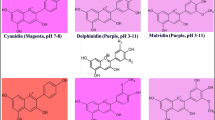Abstract
Main conclusion
Biochemical, transgenic, and genetic complementation data demonstrate that three glutathione S-transferases are involved in the storage of anthocyanins, flavonols, and proanthocyanins in plant cells.
Abstract
Flavonoids are compounds in tea (Camellia sinensis) that confer the characteristic astringent taste of tea beverages; these compounds have numerous benefits for human health. In plant cells, flavonoids are synthesized in different locations within the cytoplasm and are then transported and finally stored in vacuoles. To date, the mechanism involved in the intracellular transport of flavonoids in tea has not been well elucidated. In this study, we report the functional characterization of three cDNAs encoding glutathione S-transferases (CsGSTs) of C. sinensis, namely, CsGSTa, CsGSTb, and CsGSTc. The expression profiles of CsGSTa and CsGSTb were positively correlated with the accumulation of flavonols, anthocyanins and proanthocyanins in tea tissues and cultivars. These three recombinant CsGSTs showed a high affinity for flavonols (kaempferol-3-O-glucoside and quercetin-3-O-glucoside) and anthocyanin (cyanidin-3-O-glucoside) in vitro but had no or weak affinity for epicatechin. In vivo, CsGSTa, CsGSTb and CsGSTc fully or partially restored the storage of anthocyanins and proanthocyanidins in transgenic tt19 mutants. Metabolic profiling revealed that the contents of anthocyanins, flavonols, and proanthocyanidins were increased in the transgenic petals of Nicotiana tabacum. Taken together, all data showed that CsGSTa, CsGSTb, and CsGSTc are associated with the storage of anthocyanins, flavonols, and proanthocyanins in C. sinensis cells.






Similar content being viewed by others
References
Akbar SM, Sreeramulu K, Sharma HC (2016) Tryptophan fluorescence quenching as a binding assay to monitor protein conformation changes in the membrane of intact mitochondria. J Bioenerg Biomembr 48(3):241–247. https://doi.org/10.1007/s10863-016-9653-0
Alfenito MR, Souer E, Goodman CD, Buell R, Mol J, Koes R, Walbot V (1998) Functional complementation of anthocyanin sequestration in the vacuole by widely divergent glutathione S-transferases. Plant Cell 10(7):1135–1149
Axarli I, Muleta AW, Vlachakis D, Kossida S, Kotzia G, Maltezos A, Dhavala P, Papageorgiou AC, Labrou NE (2016) Directed evolution of Tau class glutathione transferases reveals a site that regulates catalytic efficiency and masks co-operativity. Biochem J 473:559–570. https://doi.org/10.1042/Bj20150930
Bradford MM (1976) A rapid and sensitive method for the quantitation of microgram quantities of protein utilizing the principle of protein-dye binding. Anal Biochem 72:248–254. https://doi.org/10.1006/abio.1976.9999
Cai XT, Xu P, Zhao PX, Liu R, Yu LH, Xiang CB (2014) Arabidopsis ERF109 mediates cross-talk between jasmonic acid and auxin biosynthesis during lateral root formation. Nat Commun. https://doi.org/10.1038/ncomms6833
Conn S, Curtin C, Bezier A, Franco C, Zhang W (2008) Purification, molecular cloning, and characterization of glutathione S-transferases (GSTs) from pigmented Vitis vinifera L. cell suspension cultures as putative anthocyanin transport proteins. J Exp Bot 59(13):3621–3634. https://doi.org/10.1093/jxb/ern217
Conn S, Franco C, Zhang W (2010) Characterization of anthocyanic vacuolar inclusions in Vitis vinifera L. cell suspension cultures. Planta 231(6):1343–1360. https://doi.org/10.1007/s00425-010-1139-4
Dixon DP, Edwards R (2010) Glutathione transferases. Arabidopsis Book 8:e0131. https://doi.org/10.1199/tab.0131
Dixon DP, Davis BG, Edwards R (2002) Functional divergence in the glutathione transferase superfamily in plants. Identification of two classes with putative functions in redox homeostasis in Arabidopsis thaliana. J Biol Chem 277(34):30859–30869. https://doi.org/10.1074/jbc.m202919200
Edwards R, Dixon DP, Walbot V (2000) Plant glutathione S-transferases: enzymes with multiple functions in sickness and in health. Trends Plant Sci 5(5):193–198. https://doi.org/10.1016/S1360-1385(00)01601-0
Gomez C, Conejero G, Torregrosa L, Cheynier V, Terrier N, Ageorges A (2011) In vivo grapevine anthocyanin transport involves vesicle-mediated trafficking and the contribution of anthoMATE transporters and GST. Plant J 67(6):960–970. https://doi.org/10.1111/j.1365-313X.2011.04648.x
Han XM, Yang ZL, Liu YJ, Yang HL, Zeng QY (2018) Genome-wide profiling of expression and biochemical functions of the Medicago glutathione S-transferase gene family. Plant Physiol Biochem 126:126–133. https://doi.org/10.1016/j.plaphy.2018.03.004
Huang RN, Zhang SX, Pan LL, Li J, Liu F, Liu HJ (2013) Spectroscopic studies on the interactions between imidazolium chloride ionic liquids and bovine serum albumin. Spectrochim Acta A 104:377–382. https://doi.org/10.1016/j.saa.2012.11.087
Jiang X, Liu Y, Li W, Zhao L, Meng F, Wang Y, Tan H, Yang H, Wei C, Wan X, Gao L, Xia T (2013) Tissue-specific, development-dependent phenolic compounds accumulation profile and gene expression pattern in tea plant [Camellia sinensis]. PLoS One 8(4):e62315. https://doi.org/10.1371/journal.pone.0062315
Justyna M, Kamil K, Anna K (2014) Flavonoids as important molecules of plant interactions with the environment. Molecules 19(10):16240–16265. https://doi.org/10.3390/molecules191016240
Kathiravan A, Chandramohan M, Renganathan R, Sekar S (2009) Spectroscopic studies on the interaction between phycocyanin and bovine serum albumin. J Mol Struct 919(1–3):210–214. https://doi.org/10.1016/j.molstruc.2008.09.005
Kitamura S, Shikazono N, Tanaka A (2004) TRANSPARENT TESTA 19 is involved in the accumulation of both anthocyanins and proanthocyanidins in Arabidopsis. Plant J 37(1):104–114. https://doi.org/10.1046/j.1365-313X.2003.01943.x
Kitamura S, Akita Y, Ishizaka H, Narumi I, Tanaka A (2012) Molecular characterization of an anthocyanin-related glutathione S-transferase gene in cyclamen. J Plant Physiol 169(6):636–642. https://doi.org/10.1016/j.jplph.2011.12.011
Labrou NE, Papageorgiou AC, Pavli O, Flemetakis E (2015) Plant GSTome: structure and functional role in xenome network and plant stress response. Curr Opin Biotechnol 32:186–194. https://doi.org/10.1016/j.copbio.2014.12.024
Li XA, Gao P, Cui DJ, Wu LM, Parkin I, Saberianfar R, Menassa R, Pan HY, Westcott N, Gruber MY (2011) The Arabidopsis tt19-4 mutant differentially accumulates proanthocyanidin and anthocyanin through a 3′ amino acid substitution in glutathione S-transferase. Plant Cell Environ 34(3):374–388. https://doi.org/10.1111/j.1365-3040.2010.02249.x
Licciardello C, D’Agostino N, Traini A, Recupero GR, Frusciante L, Chiusano ML (2014) Characterization of the glutathione S-transferase gene family through ESTs and expression analyses within common and pigmented cultivars of Citrus sinensis (L.) Osbeck. Bmc Plant Biol. https://doi.org/10.1186/1471-2229-14-39
Liu YJ, Han XM, Ren LL, Yang HL, Zeng QY (2013) Functional divergence of the glutathione S-transferase supergene family in Physcomitrella patens reveals complex patterns of large gene family evolution in land plants. Plant Physiol 161(2):773–786. https://doi.org/10.1104/pp.112.205815
Luo H, Dai C, Li Y, Feng J, Liu Z, Kang C (2018) Reduced anthocyanins in Petioles codes for a GST anthocyanin transporter that is essential for the foliage and fruit coloration in strawberry. J Exp Bot 69(10):2595–2608. https://doi.org/10.1093/jxb/ery096
Marrs KA, Alfenito MR, Lloyd AM, Walbot V (1995) A glutathione S-transferase involved in vacuolar transfer encoded by the maize gene Bronze-2. Nature 375(6530):397–400. https://doi.org/10.1038/375397a0
Panche AN, Diwan AD, Chandra SR (2016) Flavonoids: an overview. J Nutr Sci 5:e47. https://doi.org/10.1017/jns.2016.41
Pang Y, Peel GJ, Wright E, Wang Z, Dixon RA (2007) Early steps in proanthocyanidin biosynthesis in the model legume Medicago truncatula. Plant Physiol 145(3):601–615. https://doi.org/10.1104/pp.107.107326
Pegeot H, Koh CS, Petre B, Mathiot S, Duplessis S, Hecker A, Didierjean C, Rouhier N (2014) The poplar Phi class glutathione transferase: expression, activity and structure of GSTF1. Front Plant Sci 5:712. https://doi.org/10.3389/fpls.2014.00712
Perez-Diaz R, Madrid-Espinoza J, Salinas-Cornejo J, Gonzalez-Villanueva E, Ruiz-Lara S (2016) Differential Roles for VviGST1, VviGST3, and VviGST4 in proanthocyanidin and anthocyanin transport in Vitis vinifera. Front Plant Sci 7:1166. https://doi.org/10.3389/fpls.2016.01166
Pfaffl MW (2001) A new mathematical model for relative quantification in real-time RT-PCR. Nucleic Acids Res 29(9):e45
Pourcel L, Irani NG, Lu Y, Riedl K, Schwartz S, Grotewold E (2010) The formation of anthocyanic vacuolar inclusions in Arabidopsis thaliana and implications for the sequestration of anthocyanin pigments. Mol Plant 3(1):78–90. https://doi.org/10.1093/mp/ssp071
Poustka F, Irani NG, Feller A, Lu Y, Pourcel L, Frame K, Grotewold E (2007) A trafficking pathway for anthocyanins overlaps with the endoplasmic reticulum-to-vacuole protein-sorting route in Arabidopsis and contributes to the formation of vacuolar inclusions. Plant Physiol 145(4):1323–1335. https://doi.org/10.1104/pp.107.105064
Sappl PG, Carroll AJ, Clifton R, Lister R, Whelan J, Harvey Millar A, Singh KB (2009) The Arabidopsis glutathione transferase gene family displays complex stress regulation and co-silencing multiple genes results in altered metabolic sensitivity to oxidative stress. Plant J 58(1):53–68. https://doi.org/10.1111/j.1365-313X.2008.03761.x
Scharbert S, Hofmann T (2005) Molecular definition of black tea taste by means of quantitative studies, taste reconstitution, and omission experiments. J Agric Food Chem 53(13):5377–5384. https://doi.org/10.1021/jf050294d
Soranzo N, Sari Gorla M, Mizzi L, De Toma G, Frova C (2004) Organisation and structural evolution of the rice glutathione S-transferase gene family. Mol Gene Genom 271(5):511–521. https://doi.org/10.1007/s00438-004-1006-8
Ting L, Zhi-Ling Y, Xue Y, Yan-Jing L, Xiao-Ru W, Qing-Yin Z (2009) Extensive functional diversification of the Populus glutathione S-transferase supergene family. Plant Cell 21(12):3749–3766. https://doi.org/10.1105/tpc.109.070219
Wang PQ, Zhang LJ, Jiang XL, Dai XL, Xu LJ, Li T, Xing DW, Li YZ, Li MZ, Gao LP, Xia T (2018a) Evolutionary and functional characterization of leucoanthocyanidin reductases from Camellia sinensis. Planta 247(1):139–154. https://doi.org/10.1007/s00425-017-2771-z
Wang WZ, Zhou YH, Wu YL, Dai XL, Liu YJ, Qian YM, Li MZ, Jiang XL, Wang YS, Gao LP, Xia T (2018b) Insight into catechins metabolic pathways of Camellia sinensis based on genome and transcriptome analysis. J Agric Food Chem 66(16):4281–4293. https://doi.org/10.1021/acs.jafc.8b00946
Xie DY, Dixon RA (2005) Proanthocyanidin biosynthesis–still more questions than answers? Phytochemistry 66(18):2127–2144. https://doi.org/10.1016/j.phytochem.2005.01.008
Xu YQ, Zhang YN, Chen JX, Wang F, Du QZ, Yin JF (2018) Quantitative analyses of the bitterness and astringency of catechins from green tea. Food Chem 258:16–24. https://doi.org/10.1016/j.foodchem.2018.03.042
Yamazaki M, Shibata M, Nishiyama Y, Springob K, Kitayama M, Shimada N, Aoki T, Ayabe S, Saito K (2008) Differential gene expression profiles of red and green forms of Perilla frutescens leading to comprehensive identification of anthocyanin biosynthetic genes. FEBS J 275(13):3494–3502. https://doi.org/10.1111/j.1742-4658.2008.06496.x
Yan Jing L, Xue Min H, Lin Ling R, Hai Ling Y, Qing Yin Z (2013) Functional divergence of the glutathione S-transferase supergene family in Physcomitrella patens reveals complex patterns of large gene family evolution in land plants. Plant Physiol 161(2):773–786. https://doi.org/10.1104/pp.112.205815
Zhao J (2015) Flavonoid transport mechanisms: how to go, and with whom. Trends Plant Sci 20(9):576–585. https://doi.org/10.1016/j.tplants.2015.06.007
Acknowledgements
This work was supported by National Key Research and Development Program of China (2018YFD1000601), the Natural Science Foundation of China (31870677, 31870676, 31570694, 31470689), the Collegiate Natural Science Foundation of Anhui Province (03087060).
Author information
Authors and Affiliations
Corresponding authors
Additional information
Publisher's Note
Springer Nature remains neutral with regard to jurisdictional claims in published maps and institutional affiliations.
Electronic supplementary material
Below is the link to the electronic supplementary material.
Rights and permissions
About this article
Cite this article
Liu, Y., Jiang, H., Zhao, Y. et al. Three Camellia sinensis glutathione S-transferases are involved in the storage of anthocyanins, flavonols, and proanthocyanidins. Planta 250, 1163–1175 (2019). https://doi.org/10.1007/s00425-019-03206-2
Received:
Accepted:
Published:
Issue Date:
DOI: https://doi.org/10.1007/s00425-019-03206-2




